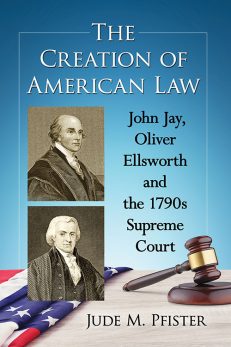The Creation of American Law
John Jay, Oliver Ellsworth and the 1790s Supreme Court
$39.95
In stock
About the Book
With the Constitutional Convention in 1787, America was set on a course to develop a unique system of law with roots in the English common law tradition. This new system, its foundations in Article III of the Constitution, called for a national judiciary headed by a supreme court—which first met in 1790.
This book serves as a history of America’s national law with a look at those—such as John Jay (the first Chief), James Iredell, Bushrod Washington and James Wilson—who set in motion not only the new Supreme Court, but also the new federal judiciary. These Founders displayed great dexterity in maneuvering through the fraught political landscape of the 1790s.
About the Author(s)
Bibliographic Details
Jude M. Pfister
Format: softcover (6 x 9)
Pages: 280
Bibliographic Info: 23 photos, appendices, notes, bibliography, index
Copyright Date: 2019
pISBN: 978-1-4766-6908-3
eISBN: 978-1-4766-3355-8
Imprint: McFarland
Table of Contents
Acknowledgments vi
Preface 1
Introduction 7
1. Colonial American Law 13
2. The Constitutional Convention and The Federalist Papers 38
3. The Judiciary Act of 1789 61
4. Important Individuals 1789–1800 85
5. The John Jay Court: September 26, 1789–June 29, 1795 135
6. The John Rutledge Court: June 30, 1795–December 28, 1795 183
7. The Oliver Ellsworth Court: March 8, 1796–September 30, 1800 191
8. The Supreme Court and the Alien and Sedition Acts Cases 206
9. Presidents Washington and Adams and the Law 220
Appendix A: Article III of the United States Constitution 227
Appendix B: Selections from the Judiciary Act of 1789 229
Appendix C: Chief Justice John Jay’s Instructions to a New York Grand Jury, April 4, 1790 231
Appendix D: President John Adams and John Jay 233
Appendix E: A Place to Call Home 235
Chapter Notes 239
Bibliography 265
Index 271





